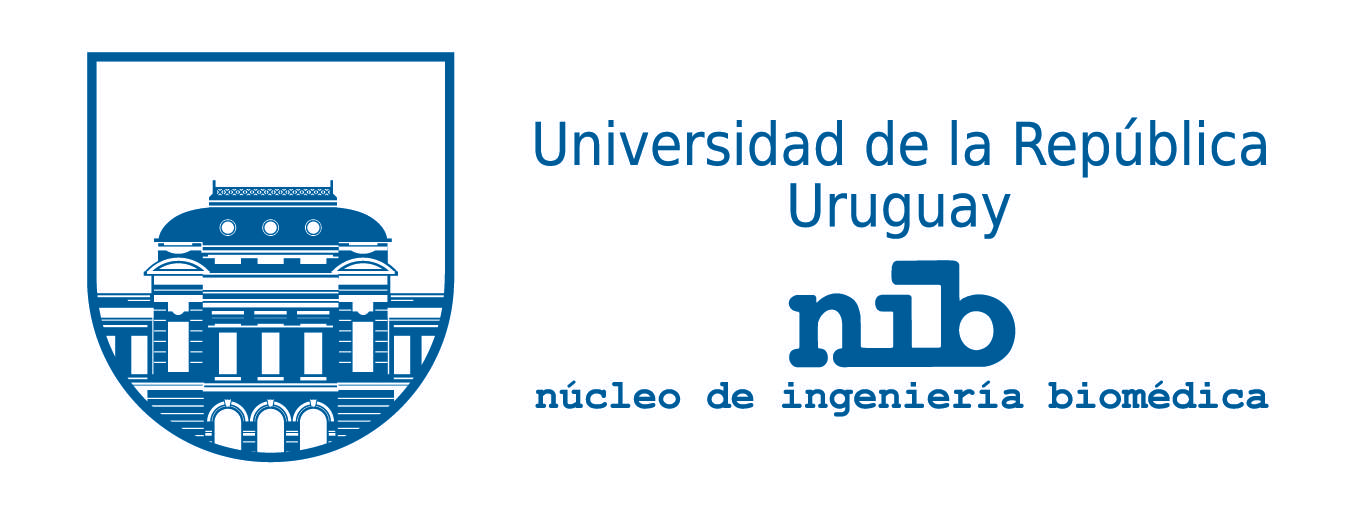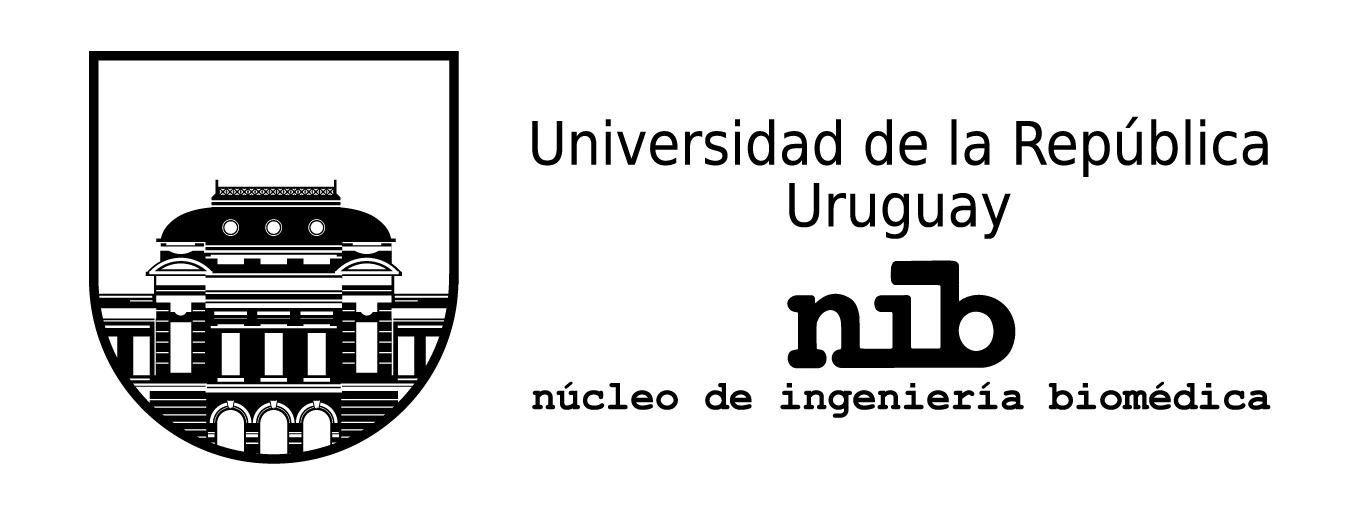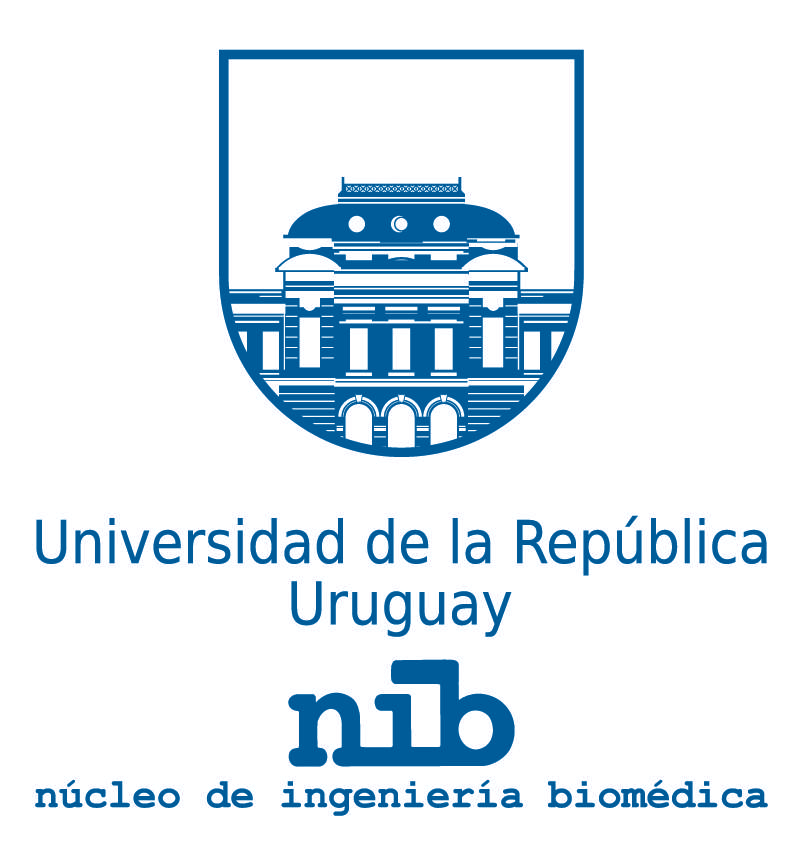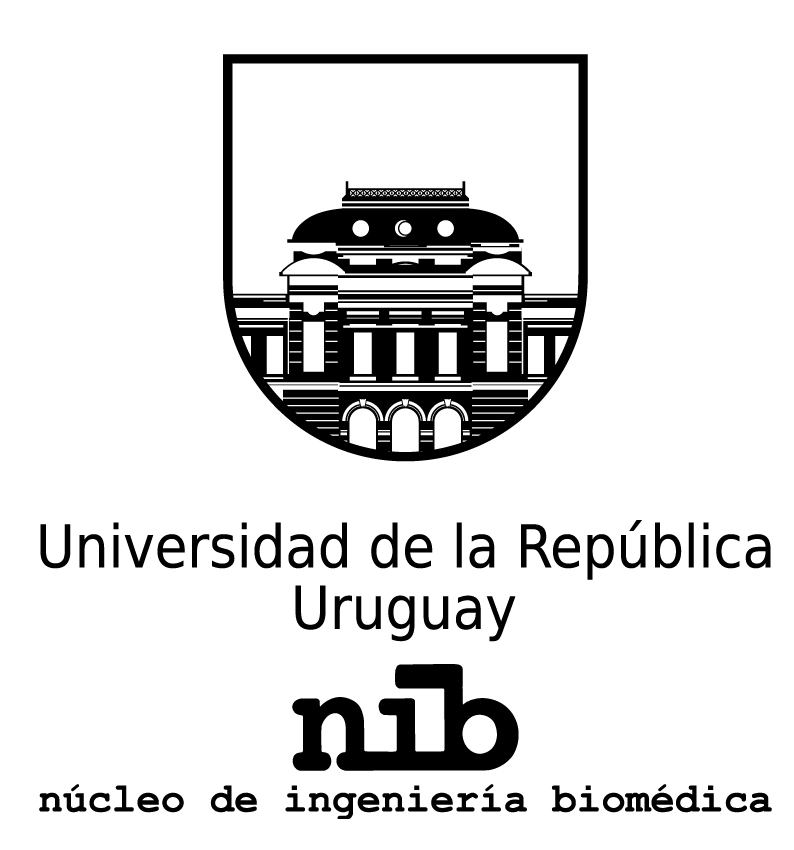Updated on April 11, 2024
The Biomedical Engineering Departament (NIB) of the Faculties of Medicine and Engineering is an interdisciplinary group active in teaching, research and
technology transfer in Biomedical Engineering and Medical Informatics. NIB contributes to the training in Biomedical Engineering to face the challenges of
medical instrumentation in health institutions. Its participation in university outreach is divided between the contribution to assistance and the involvement of
students in projects in the area.
Activities:
Núcleo de Ingeniería Biomédica
Hospital de Clínicas, piso 15 sala 2
11600 Montevideo, URUGUAY
tel.: +598 1953 ext 4406 ext 4438
nib@fmed.edu.uy
Updated on April 11, 2024
The background of NIB (Biomedical Engineering Departament) can be found in the work teams promoted by Dr. Caldeyro Barcia in the
1960s and 1970s in which electronic technicians (Jorge Pantle, Hugo Cervetti, Carlos Avallone) collaborated in physiological
research; equipment for the amplification of biological signals and the detection of foetal heartbeats by ultrasound were developed.
At the Faculty of Medicine, engineers (Pablo Handler, Félix Azar, Ruben Budelli) worked in pioneering stages of the use of computers
in neurophysiological research (1970 to 1973).
At the impulse of Dr. Eduardo Touya, Dr. Mario Médici and other doctors, in the 1970s and 1980s, business developments of equipment
for nuclear medicine, clinical neurophysiology and cardiovascular signal monitors were born (Interfase Ltda., GMS Ltda., then Controles
S.A., Dr. Horacio Venturino). The creation in 1982 of the first position of Clinical Engineer in a mutual institution (CASMU, Eng. Pedro
Tonarelli) was an indication of the need to develop the speciality.
In 1984 a description of Biomedical Engineering was published at the 1st . (Franco Simini), which motivated the beginning of a continuous
interest of engineering students in Biomedical Engineering. Engineering students are presented at NIB looking for electronic or mechanical
projects to undertake and thus culminate their careers with biomedical knowledge. Simultaneously, several clinical services of the University
Hospital (Dr. Héctor Píriz, Dr. Hernán Artucio, etc.) and basic research groups (Dr. Ricardo Velluti, Dr. Omar Macadar, Dr. Omar Trujillo)
express their need for equipment and methodology for research, diagnostic and therapeutic methods. The clinical needs for original equipment
are addressed by students and teachers who thus set up lines of research.
The first prototypes of biomedical equipment developed by teachers and students enter clinical service in 1987, with funding from research centres (CLAP) or development agencies (CONICYT) that support departments of the Faculty of Medicine. In 1990, on the basis of a set of concrete achievements, the Faculties of Medicine and Engineering (deans Dr. Pablo Carlevaro and Eng. A. Abete respectively) agree to create NIB on the basis of the principle of equal division of costs. In 1991 the first teaching post of coordinator was created (called for competition in 1993, and Franco Simini was appointed). The impulse of both faculty councils (deans Dr. Touya and Eng. Rafael Guarga) allows the consolidation of NIB from 1994 to 1997 with the support of CONICYT and the central structures of the University, which finances 5 teaching positions in training.
Since the creation of NIB, the Department of Automatic Control and Industrial Electronics (today the Dept. of Systems and Control) at the Institute of Electrical Engineering of the Faculty of Engineering is its reference structure. At the Hospital de Clínicas (HC), the CLAP (PAHO/WHO Perinatology Centre) and the Department of Physiopathology share their activities with NIB in nearby premises. Numerous clinical departments (at HC and in other hospitals and clinics) collaborate with NIB in the definition and development of equipment and computer applications for medicine. International collaboration and collaboration with companies strengthen the potential of NIB. In the Faculty of Engineering, the Institutes of Computer Science, Industrial Mechanics and others collaborate through the participation of students and teachers in NIB projects and their interdisciplinary training plans.
The panel consisted of:
Good morning and thank you for the large attendance at this presentation of the NIB. The NIB is an academic structure that responds
to two faculties of our University, the Faculty of Medicine and the Faculty of Engineering. As this is a new development, a commitment
to a new way of working, the Faculty of Medicine and the Faculty of Engineering felt the need to analyse the path they have taken.
On the occasion of the inauguration of new premises provided by CLAP (Centro Latinoamericano de Perinatología y Desarrollo Humano OPS/OMS)
as part of their collaboration, we have prepared this condensed data for your evaluation.
We are grateful for the support of CLAP, in whose classrooms we currently find ourselves, which as an expression of the willingness
of the Ministry of Public Health, the Ministry of Health and the Ministry of Health, to cooperate with us in the preparation of this report.
of the Ministry of Public Health, PAHO/WHO and our University, is an integral part of this teaching and research effort. teaching and research
effort. The director of CLAP who welcomes us is Dr. José Miguel Belizán.
We are grateful to the Hospital de Clínicas, with whose clinics and departments the NIB collaborates intensively as we shall see, to
enable us to realise concrete projects and to be a source of creative inspiration by sharing care and research needs. The Hospital de Clínicas
is among us in the person of its director Prof. Dr. Alallón and the President of its Board of Directors, Dr. Enrique Besada, represented today
by Dr. Henry Cohen.
We thank the Faculties of Medicine and Engineering whose teachers contribute to the university work with constant dedication and desire
for improvement. With us this morning are Professor Engineer María Simón and Prof. Dr. Luis Calegari, whose presence we would like to thank.
On this day we must especially thank the Faculty of Science which, in the person of its dean Prof. Dr. Ricardo Ehrlich, wanted to join
us to reaffirm the commitment of the science teachers who participated with great generosity to the common task in seminars and specific advice
on specific topics.
In the Faculty of Medicine, there are many partners and the list is too long; however, there is a vocation to cooperate with the
Department of Physiopathology (Prof. Dr. Héctor Píriz) due to geographical and methodological proximity and the natural complementarity of
their competencies. In the Faculty of Engineering, the Department that supports and backs up our work is the Department of Industrial Control
and Electronics (Prof. Ing. Rafael Canetti).
The activities of the NIB are constantly supported by CLAP (PAHO/WHO); the NIB is implementing a CONICYT project and was able to hire
5 lecturers for two years thanks to the competitive award of funding from the Institutional Strengthening programme of the Sectoral Commission
for Scientific Research (CSIC).
This presentation is possible thanks to the efforts of many people whom we thank here: the Hospital's cleaning staff, the telephone
section and the entire maintenance team on floor 6. On the 4th floor, the team of students, computer scholarship holders and librarians will
allow us to see the website of the Biomedical Engineering Nucleus on this giant screen of the CLAP. Special thanks to the Electronic Section,
the general services group and all the CLAP staff for the coordinated tasks carried out with great efficiency. coordinated tasks carried out
with great efficiency.
Special thanks to the clinical and research groups with whom we've defined and then built prototypes for medical use over the years:
this work wouldn't have been possible without the contribution of the students who dedicate themselves to this task with enthusiasm and dedication.
Recognised and formally initiated by the deans Ing. Abete and Dr. Carlevaro, the NIB has been consolidated by the joint action of the
deans Dr. Touya and Ing. Our multidisciplinary task with a view to creating a reference of excellence in health services, closely related to
research and teaching, is naturally framed by the organisation proposed by the Medical Centre project. Thus, the total dedication to university
activity that we are privileged to be able to maintain constitutes a foretaste of the status of driving force, reference and spearhead that we
want for our HC in the entire health system of Uruguay, with a projection of complementarity in the region.
Last but not least, we would like to thank the Rector of the University, Prof. Ing. Rafael Guarga for his enthusiastic acceptance of
our invitation.
This meeting will now continue with the presentation of some slides describing the activities of the NIB, after which those members
of the table who so wish will address a few words to us, which must necessarily be telegraphic, as the Rector has other commitments to attend
to just after 9 o'clock. Before his departure, we will have the pleasure of accompanying them on a brief tour of the three laboratories just a
few metres from here, in room 2 of this 15th floor.
Eng. Rafael Canetti highlights the research and development efforts shared by two faculties.
Eng. Rafael Guarga (Rector of the University) points out that joint ventures are expansive in the modern university because of their
success and their multiplying power.
Dr. J.M. Belizán presented the vocation of CLAP as a pioneering centre in Latin America and its willingness to cooperate in research.
Eng. Franco Simini presented slides with descriptions of the biomedical equipment developed and on the activities of the NIB: Seminar
and Course on Biomedical Engineering, certification of equipment for clinical use and research.
Eng. María Simón (Dean of Engineering) highlights the achievements obtained and proposes the continuity of the positions in the
Biomedical Engineering Nucleus that are currently term positions.
Dr. Luis Calegari (Dean of Medicine) agrees with Dean Simón on the need to give continuity to the economic effort of the faculties
to maintain the NIB in activity.
Visit of the Rector, the other members of the board and attendees in general to the NIB laboratories where the instruments and the
development infrastructure were presented.
The NIB teachers were present: Fernando Nieto, Pablo Musé, Rafael Sanguinetti, Franco Simini and Martín Vallarino.
It is estimated that 40 people attended, including HC professors, medical teachers, teachers from the Faculty of Engineering and the
Faculty of Sciences, representatives of the press, students and businessmen from the biomedical equipment industry.
At 9:15 a.m., the Rector leaves, and an informal academic exchange takes place among those present.
Updated on April 11, 2024
February 16, 2001:
Dr Fernando Nieto has left us. Unexpectedly, he left on a Friday afternoon, having completed his work and close to the
bus stop that would take him home. It is difficult to assimilate this painful fact and to become aware of the irreparable loss
that this sudden absence means.
A cardiologist, an exceptional teacher and a brilliant researcher, Nieto had a conciliatory and generous personality.
I met Nieto when, called to collaborate with Dr. Caldeyro Barcia at the Latin American Centre for Perinatology and Human Development
(CLAP), he immediately offered me to share his desk, his disinterested collaboration and his friendship. In more than two decades we
have worked together on many projects for which Nieto's constant and confident dedication has been central. Professional ability,
discretion and nobility marked all his endeavours.
It is not possible to enumerate Nieto's contributions to the scientific life of Uruguay and Latin America in this immediate
evocation: the task of consolidating his work with the calm that the surprise and pain of his departure has left us with is still
pending. However, we mention his contribution to the Basic Cycle of the Faculty of Medicine, the statistical structuring of the
scientific production of Dr. Roberto Caldeyro Barcia and his successor in the direction of CLAP, Dr. Ricardo Schwarcz, the teaching
and research of the Faculty of Medicine, and the work of Dr. Roberto Caldeyro Barcia and his successor in the direction of CLAP, Dr.
Ricardo Schwarcz. Ricardo Schwarcz, the teaching of statistics to the numerous CLAP scholarship holders from all over Latin America,
his teaching and assistance in cardiology in MSP centres and mutual entities, his active collaboration in a large number of research
projects in practically all the Departments and Clinics of the Hospital de Clínicas, his active and decisive participation in the
foundation and development of the Núcleo de Ingeniería Biomedica (NIB) as a shared entity between the Faculties of Medicine and
Engineering, and his contribution to the development of the NIB.
Dr. Nieto, a clinician and biostatistician, was also an electronic engineer: his in-depth knowledge of the design and
realisation of electronic circuits, in addition to his experience in computer programming, allowed him to develop original equipment,
to direct the project of engineering students who opt for biomedical specialisation, and to make substantive contributions in
technical engineering forums.
On Tuesday, February 6, at the Faculty of Engineering, the class awaiting Prof. Nieto received the incredible news with
silence and remembrance, later transformed into two hours of deep application, demonstrating the appreciation and affection the
students feel for Nieto.
Dr. Fernando Nieto leaves in his family the void of an exemplary husband and dedicated father: he lives from now on in the
thoughts and actions of Dr. Ana María Ríos de Nieto and Arq. Fernando Nieto Ríos.
In our fast-paced world, it is only belatedly that we realise the true dimension of the collaborator, the professional and
friend, when faced with the emptiness he leaves behind. And it is this sudden absence of Fernando Nieto that should stimulate us
today to continue his example of discretion, nobility and academic excellence.
Updated on April 11, 2024
Updated on April 11, 2024
Updated on April 11, 2024
González, Mariana
Serra, Federica
Bartesaghi, Mariana
Castro, Enrique
Capote, Gonzalo
Sosa, Lucía
Trías Carolina
Machado, Tatiana
Martínez, Valentina
Zugarramurdi, Mariela
Bonilla, Gastón
Rocanova, Martín
Barreiro, Martina
Sánchez, Pablo
Vera, Julián
Viera, Matías
Alzugaray, Manuel
Vega, Cristian
Vico, Sergio
Huerta, Carlos
Sainz, Samuel
Coggan,Valentina
Della Mea, Estefanía
Hourcade, Nahuel
Báez, Santiago
Larrosa, Germán
L`Olivier, Iván
Vignale, Mauricio
Lorenzo, Sebastián
Martínez, Federico
Minetti, Pablo
Ledezma, Maria Rene
Alfaro, Nicolás
Arregui ,Martín
Martinucci, Fernanda
Cervantes, Santiago
Máximo, Santiago
Ferreira, Fabián
Gómez, Santiago
Decia, Ignacio
Farías, Agustín
Olivera, Williams
Rodríguez, Marcio
Cardone, Alejandro
García, Viterbo
González, Rodrigo
Clavijo, Leonardo
Da Silva, Valentina
Roche, Paula
Strasser, Bruno
Bernadet, Gimena
Coelho, Cristiano
Conti, Emiliano
Ashby, Gastón
Ferrer, Ignacio
Command, Marcos
Elizondo, Ignacio
Fabricio, Oscar
Marichal, Eduardo
Barron, Ramiro
Cukerman, Andrea
Ortega, Juan Martin
Bonilla, Diego
Arrúa, Esteban
Sitrin, Mauro
Briozzo, Carlos
Kugelmass, Freddy
Peri, Eduardo
Cogorno, Diego
De Pro, Federico
Suzacq, Fernando
Finozzi, Gonzalo
Minetti, Germán
Sosa, Javier
Prieto, Álvaro
Vlaeminck, Rodrigo
Pereira, José
Senatore, Agustín
Touya Andrés
Bliman, Federico
Braga, Juan
Cáceres, Martín
Ramírez, Valentina
Carrasco, Leandro
Pazos, Pablo
David, Marcelo
Sánchez, Guillermo
Zoppolo, Cedric
Quinteros, Walter
Aratti, Rodrigo
Ayala, Gonzalo
Redín, Adriana
Gonzalez, Santiago
Liguori, Andres
Churi, Daniel
Forelius, Yennyfer
Hodos, Alejandro
Borca, Javier
Duarte, Rodrigo
Rodríguez, Javier
Haim, Fiorella
Hernández, Rogelio
Suárez, Rodolfo
Aguirre, Pablo
Cardelino, Juan
Loeff, Nicolás
Hartman. Raúl
Lobo, Jorge
Ruétalo, Mateo
Ferreira, Adriana
Rodríguez, Alfredo
Alonso, Rafael
Cigarán, Juan Carlos
Díaz, Leonardo
Alfaro, José
Forceltatti, Tabaré
Sarute, Fabián
Clavijo, Ricardo
Galmarini, Pablo
Pomar, Martín
Baritussio, Danilo
Bianco, Fernando
Porto, Jorge
Ingver, Ruben
Reboulaz, Juan
Shlaman, Isaac
Artia, Lauro
Escuder, Ramiro
Frugoni, Cecilia
Vallarino, Martín
Zuluaga, Oscar
Facelli, María Graciela
Gesto, Laura
Rego, Raúl
Cóppola, Gustavo
Paz, Alejandro
Pérez, Inés
Casas, Gonzalo
Ratafiá, Gabriela
Kuza, Marcel
Crego, Fernando
Giusto, Alvaro
Pérez, Juan José (AUTOVENT)
Delisante, Daniel
Del Prato, Pablo
Uturbey, Wadaed
Podestá, José Pedro
Chapt, Gabriel
Chapt, Luc
Sanguinetti, Rafael
Cassou, Eduardo
Stolovich, Jorge
Basalo, Sergio
Deambrosi, Hector
Pravia, Claudio
Updated on April 11, 2024
Biomedical Engineering interns (students) 6 months in hospitals, Biomedical Engineering Interns 6 months in Corporations
and Resident Engineers 3 years in hospitals
Updated on April 11, 2024
Updated on April 11, 2024
Lucía Ribeiro (gr. 1 2021-2023)
Estefanía Della Mea - (gr. 1 2018-2022)
Isabel Ribeiro - (gr. 1 2021-2022)
Hernán Castillo - (gr. 1 2019-2022)
Rodolfo Grosso (gr.1: 2012-2018, gr.2: 2019-2021)
Andrea Mattiozzi (2019 - 2021)
Alicia Schandy (2019 - 2020)
Rodrigo Taborda (2018-2019)
Fernando Borba (2017-2019)
Carolina Arámbulo (2018-2019, 2023-presente)
Ignacio Ferrer (gr. 2 2018)
Martín Arregui (gr.1: 2015-2017, gr.2 2017-2018)
Victoria Cuadrado (FIC) (2016-2018)
Nicolás Alfaro (2017-2018)
Gastón Ashby (2017)
Andrés Rey (2017)
Florencia Peirano (2016-2017)
José Artigas (gr 2: 2016-2017)
Mariana Sosa (2014-2017)
María José González Franco (gr.2: 2016)
Paulo Sande (gr.2: 2015-2016)
Verónica Fernández Damonte (2014-2015)
Lucía Grundel (2013-2015)
Eduardo Santos (gr.1: 2010-2012, gr.2: 2013-2015)
Fabián Dávila (2014)
Luciana Urruty (2012-2014)
Freddy Kugelmass (2012-2014)
Gustavo De Martino (2012-2014)
Florencia Arbio (2012)
Cristian da Silva (2011-2012)
Daniel Radesca (2011-2012)
Daniel Geido (2004-2012)
Jorge Lobo (2002-2012)
Sebastián Alpuy (2011)
José Pereira (2010-2011)
Adrián Silveira (2010-2011)
Marcelo David (2006-2009)
Rodrigo Filgueira (2004-2007)
Pablo Pazos (2006)
Viterbo Rodríguez (2006)
Alfonso Odriozola (2006)
Raphael Carvalho (gr.2: 2004-2006)
Santiago González (2000-2005)
Alexander Muller (2003-2004)
Fiorella Haim (2001-2003)
Rafael Sanguinetti (1997-2000)
Martín Vallarino (1998-2000)
Alvaro Gómez (1997)
Sebastián Gava (1997-1998)
Pablo Musé (1997-2000)
Updated on April 11, 2024






Updated on April 11, 2024
Folleto institucional - May 2011
Transferencia Tecnológica - May 2013
Institutional brochure - May 2012
Technology Transfer - May 2013
Updated on April 11, 2024
Updated on April 11, 2024